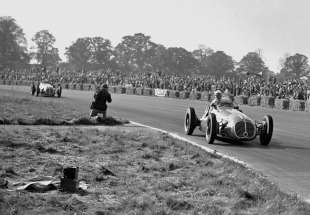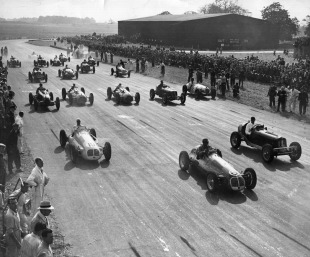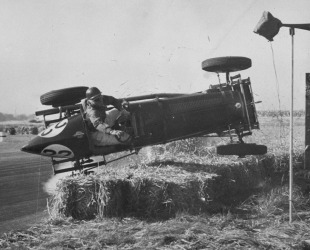Gallery of pictures from the 1948 British Grand Prix

- Drivers:
- Alberto Ascari
- |
- Louis Chiron
- |
- Bob Gerard
- |
- Gigi Villoresi
- Circuits:
- Silverstone Circuit
In the immediate aftermath of World War Two, motorsport was quick to re-establish itself in Europe despite being hampered by the fact almost no racing cars had been built since 1939 and parts were hard to come by. Races in the late 1940s were more often than not an eclectic mix of pre-war, patched-up vehicles entered by privateers and brand new machines run by factory teams.
In 1946 for FIA had drawn up a new standard set of rules - Formula One - which was to lead to the first world championship in 1950 .The first recognised grand prix run under the new rules was in Turin in 1946.
England was one country that was slower to return to normal. Severe petrol rationing in the two or three years after the war made competing difficult, and many traditional centres were out of action. Brooklands, which had staged the only two inter-war British Grands Prix, had been taken over by the authorities and some of its iconic banking demolished; Donington was a military dump; Crystal Palace was in need of major work.
Silverstone, a small aerodrome near Northampton, had been the base of 17 Operational Training Unit which prepared crews for Wellington bombers. After being decommissioned, it had been taken over by a few enthusiasts in late 1945, and word slowly spread about its suitability for racing. In 1948 the Royal Automobile Club, which had been looking for a venue where it could restart the British Grand Prix, negotiated a short lease with the Air Ministry.

Two of the three long runways formed the basis of the circuit, with smaller parts of the track connecting their ends. The length of the circuit used in 1948 was 3.7 miles, the only time this was used before it was trimmed to its traditional 2.9 miles which only used the perimeter roads.
The big names on the entry list for the October 2 race were the factory teams of Maserati, Talbot-Lego and Ferrari, although Ferrari eventually opted to remain on the continent and Alfa Romeo were never tempted. The remainder of the field were privateers in a colourful collection of machines. More than 100,000 people, starved of quality racing for almost a decade, flocked to Silverstone on a sunny autumn afternoon.
The main event was preceded two hours earlier by a 500cc race which was marked by a chaotic start - the flag went down with most drivers not even in their cars - and in which the Coopers dominated and Canadian Spike Rhiando won.
Qualifying for the Grand Prix itself had been rendered rather meaningless as the Maserati team had been delayed and arrived too late to take part. Louis Chiron, in his Ecurie France-run Talbot-Lago, took pole while the Maserati 4CLT/48 San Remos of Gigi Villoresi and Alberto Ascari had to start from the back of the 25-car field.
As soon as the race started, Villoresi and Ascari tore through the backmarkers, aided by many of the privateers soon dropping out. Most just broke down, others, such as Geoffrey Ansell in an ERA, crashed without suffering any substantial damage.
The pit stops also provided high drama as many of the privateers ended up soaked in fuel with their cockpits awash. It did not prevent them rejoining the race.

Bob Gerard in an ERA was third, more than two minutes behind the winner, while the Talbot of Louis Rosier was an even more distant fourth. They were the only three of the other 11 finishers to be on the same lap as Villoresi.
The Times noted: "The inevitable victory of the Italians with their carefully prepared and superbly-handled Maseratis, was a salutary reminder of the need for adequate British representation in a sport that is at last becoming as popular here as it always has been abroad."
The huge turnout guaranteed the British Grand Prix would not disappear without trace as it had done after 1927. It also ensured Silverstone would become British motor racing's new home.
Footnotes
- On December 20, 1948, Gerard undertook a trial of a redesigned layout at Silverstone, averaging almost 19mph a lap faster than Villoresi managed. That was to become the more familiar one used at Silverstone from 1949
- Villoresi had been an Allied prisoner-of-war from 1943 to 1945. Ascari had spent the war in neutral Switzerland
- Goodwood in Sussex, also built on an airfield (Westhampnett Aerodrome), had opened a fortnight earlier
- Almost seven years later Ascari, who four days earlier had survived plunging into the harbour during the Monaco Grand Prix, turned up at Monza to see Villoresi practice. But rather than sit on the sidelines, he took out a Ferrari, crashed and was killed instantly. "He had come here with me to watch the tests," Villoresi said. "He had no intention of taking part in them, but then his urge to be at the wheel again proved too strong."
- In 1998, 14 of the original cars along with sister cars of another seven were brought together for a three-lap reunion at the Coys International Historic Festival. Five of the original drivers attended.
Martin Williamson is managing editor of digital media ESPN EMEA
© ESPN Sports Media Ltd.
 Martin Williamson is managing editor of digital media ESPN EMEA Martin Williamson, who grew up in the era of James Hunt, Niki Lauda and sideburns, became managing editor of ESPN EMEA Digital Group in 2007 after spells with Sky Sports, Sportal and Cricinfo
Martin Williamson is managing editor of digital media ESPN EMEA Martin Williamson, who grew up in the era of James Hunt, Niki Lauda and sideburns, became managing editor of ESPN EMEA Digital Group in 2007 after spells with Sky Sports, Sportal and Cricinfo

